As the new year started, I thought about what is important to me. To keep my line of thoughts, I brainstormed a phrase for each month. So far, I came up with ‘collecting moments’ for January, and I chose ‘doing more of what you love’ or follow your passion for February.
I realized that my students’ work in the unit “Visible e Invisible,” where we talked about ‘identity,’ encompasses both phrases perfectly: “moments” and “passions.” One definition of ‘identity’ describes it as “the characteristics determining who a person is or group of people are.”
In some earlier posts, I wrote about ways I work on identity and what I do for projects. If you are interested in reading about those topics, here they are:
- Professional and Personal Experiences Inform My Language Curriculum
- Why We Teach To Describe People the Way We Do
- Authentic Resources with the Smithsonian Learning Lab
- ‘P’ is for Project in World Language Classes
Throughout the unit on ‘identity’ students went deep into learning, thinking, and expressing themselves about who they are, describing both the visible and invisible parts of -self.
Including all Modes of Communication
As a language teacher I make sure that projects include all forms of communication. Interpretive tasks, such as reading articles or watching videos, interpersonal, and presentational tasks related to the topic. The presentational tasks are usually the culmination of the project where students bring together what they learned throughout the unit.
A couple of resources I used for the interpretive reading and listening are an article on the ‘iceberg cultural’ and the story “El dia en que descubres quien eres” by Jacqueline Woodson, which I read aloud.
Students learned basic ways of saying who they are and what they are like in this unit geared towards the interpersonal mode of communication. Some resources that we used included Amy Lenord’s “Yo” unit and “Mi red personal,” an activity I did in an ISTE professional development webinar a few years ago. These activities and tasks helped students talk about themselves during T.A.L.K. practices and assessments.
I incorporated art into the unit. Students analyzed art like ‘Braiding’ by Lin Tianmiao and ‘Caja de memoria viva’ by Adrián “Viajero” Román (see: Professional and Personal Experiences Inform My Language Curriculum for more information about these pieces of art) to help them understand the concepts of visible and invisible developed in the unit.
The final project included a drawing of a half-face to represent the visible and invisible parts of self, writing a composition/essay, and recording a video where they talked about themselves using FLIP. After they completed the tasks, I asked them to complete a reflection about what they learned and I was amazed reading them.

Students’ Reflections
Let me share some so you can see for yourself,
- I am proud that I wrote a whole essay in Spanish. I liked that we got to draw as part of the project. I learned that I know more vocabulary in Spanish than I thought and I learned that everyone has a different personality.
- I learned more about identity and more vocabulary. I also realized that identity has a deeper meaning. I hope people who view my artwork realize that the half face is to show the ‘visible e invisible’ on a person. I learned that everyone may not seem as they appear. I learned a lot of new words and their meanings so I can create more complex sentences.
- I liked how I was able to learn more about myself because I described myself in a different way. I am proud of my drawing because I put down all the characteristics that make me, me. I learned that people see themselves in a way I could not see them, and I learned more about what they think of themselves and tried to make them feel like I understood them.
- When I look at my self-portrait, I want people to know that there is more to everyone than what meets the eye. Even if someone is your best friend there are still many things you don’t know about them.
The QR codes from their recordings and the half-face drawing were displayed outside the classroom, so the community could learn more about who my students are. 🙂
Moments and passions also guided my students in their “Visible and Invisible” unit on identity. I wonder what phrases will guide me in the months to come.

One thought on “Visible and Invisible – Teaching Identity in World Languages”